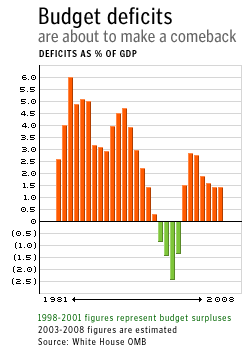NEW YORK (CNN/Money) -
Talk about biting the hand that feeds you. Just days after President Bush promised to give Alan Greenspan another term at the helm of the Federal Reserve, the chairman again stuck it to Bush's pet project, a $726 billion tax-cut plan.
He even added another wrinkle Wednesday, saying a recent Fed economist's study drew a compelling connection between higher deficits and higher interest rates.
The study, released late last week, said that interest rates rose 0.25 percentage point for every projected one percentage point increase in the ratio of the federal deficit to gross domestic product (GDP).

Thus, if the federal deficit balloons to 3 percent of GDP by 2004 as a result of the president's tax plan, as a recent Congressional Budget Office study found it might, then interest rates could rise 0.75 percentage point.
Greenspan, in response to a question from Rep. Barney Frank, D-Mass., said the study had strengthened his impression of the impact of deficits on long-term rates.
"Somewhat to my surprise, this came out as a far more robust relationship, indicating the greater the deficit, the greater the long-run interest rate," Greenspan said.
The relationship between interest rates and the deficit has long been a controversial one. Lately, Democrats have argued against the president's tax-cut plan, in part by warning that ballooning deficits would raise interest rates because they would force the government to issue more bonds, forcing corporations to battle to attract lenders by pushing the interest rates for their own bonds higher.
Republicans have dismissed this argument. They note the market has expected higher future deficits for several months, but interest rates are relatively flat -- the yield on the 10-year Treasury note, for example, isn't much higher than it was at the beginning of the year.
| Greenspan sees growth
|

|
 In Wednesday's testimony, the central bank chairman told Congress businesses still are wary and timing of a rebound is uncertain. (more)
In Wednesday's testimony, the central bank chairman told Congress businesses still are wary and timing of a rebound is uncertain. (more)
|
|
|
|
As long as economic activity and corporate demand for credit are weak, many economists argue, there's little risk of government bonds "crowding out" corporate bonds on the market.
But that relationship could change when corporate demand for credit picks up, which will likely happen when the economy improves -- and, of course, economic improvement is the stated goal of the president's tax plan.
Greenspan noted that the recent Fed study ironed out the effects of economic ups and downs on interest rates and still found a clear connection between deficits and rates.
| 
| |

| 
| 
|

|
 Federal Reserve Chairman Alan Greenspan testified before the House Financial Services Committee, and said he sees a number of encouraging signs in the economy. CNN's Louise Schiavone reports. Federal Reserve Chairman Alan Greenspan testified before the House Financial Services Committee, and said he sees a number of encouraging signs in the economy. CNN's Louise Schiavone reports.
|
|
Play video
(QuickTime, Real or Windows Media)
|
| 
|

|
|
"I thought it was an exceptionally good study," Greenspan said.
President Bush likely didn't think Greenspan's testimony was "exceptionally good." Not only did Greenspan echo his previous comments that monetary stimulus -- such as cutting interest rates, which the Fed does from time to time -- was more effective at stimulating the economy in the short term than fiscal stimulus such as tax cuts.
While supporting cuts on capital taxes and expressing admiration for the idea of eliminating the double taxation of dividends, Greenspan also said he thought any such cut must be accompanied by spending cuts.
"There are powerful reasons to suspect that the elimination of the double taxation of dividends and cuts in marginal rates will elevate long-term productivity," he said. "If, however, in the process we get a significant increase in deficits, which induce a rise in long-term interest rates, that will be a significant undercutting of the benefits achieved by tax cuts."
Just eight days ago, President Bush ignored Greenspan's earlier comments, which might have encouraged Congress to slash his tax cut proposal, and said he'd give Greenspan another term as chairman. Greenspan, 77, said he would accept another term, which would end in February 2006.

|

